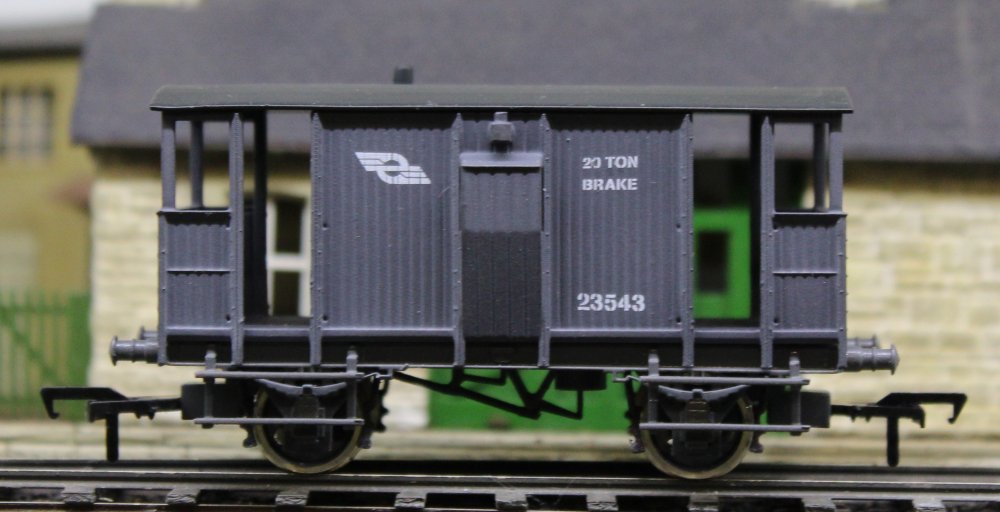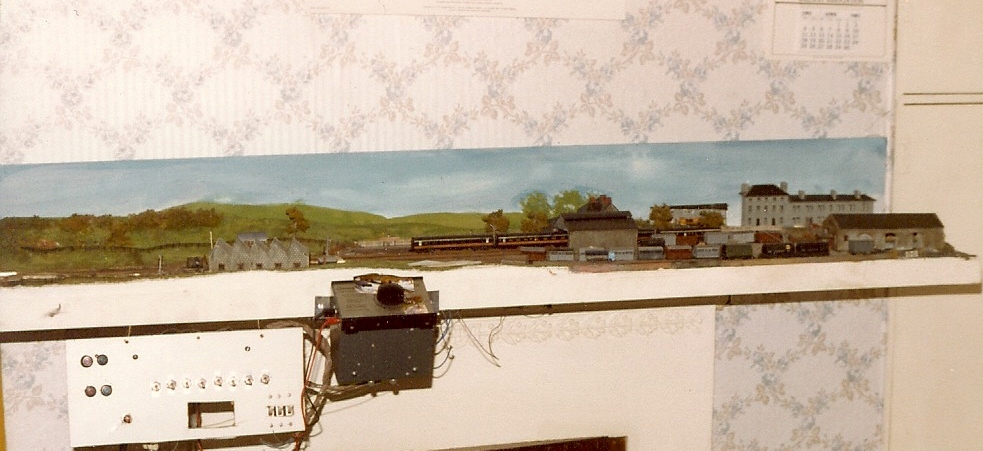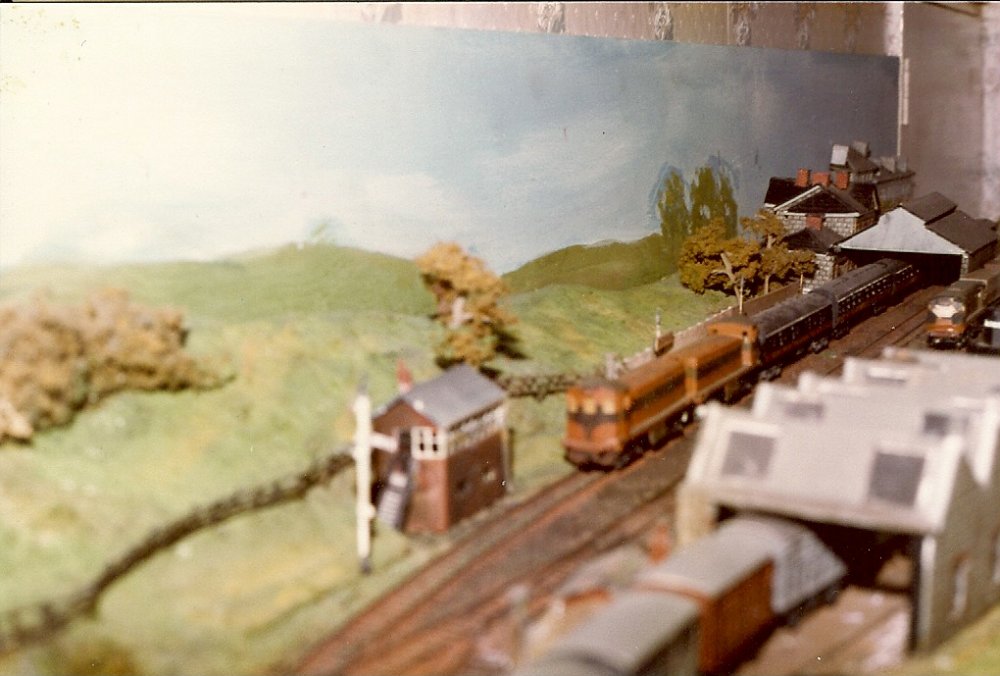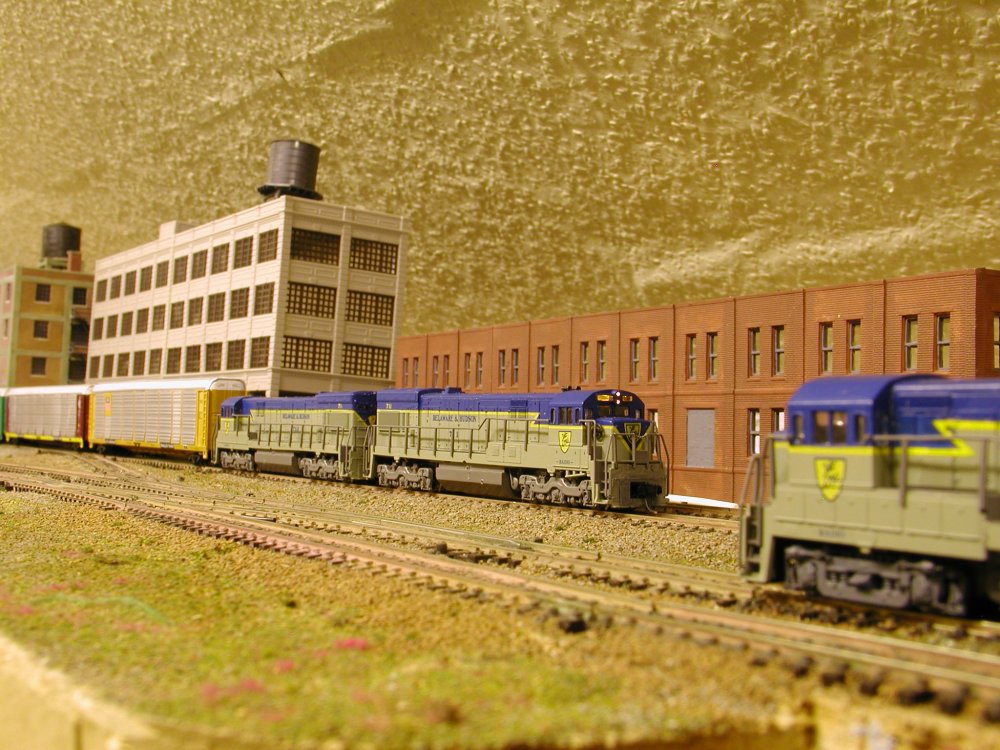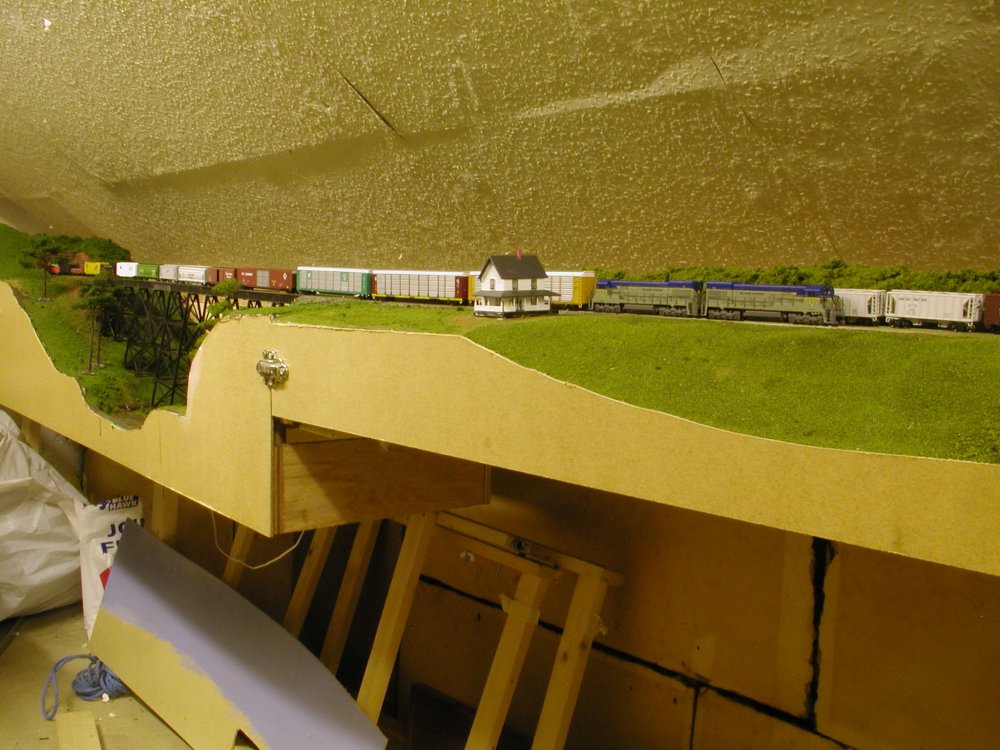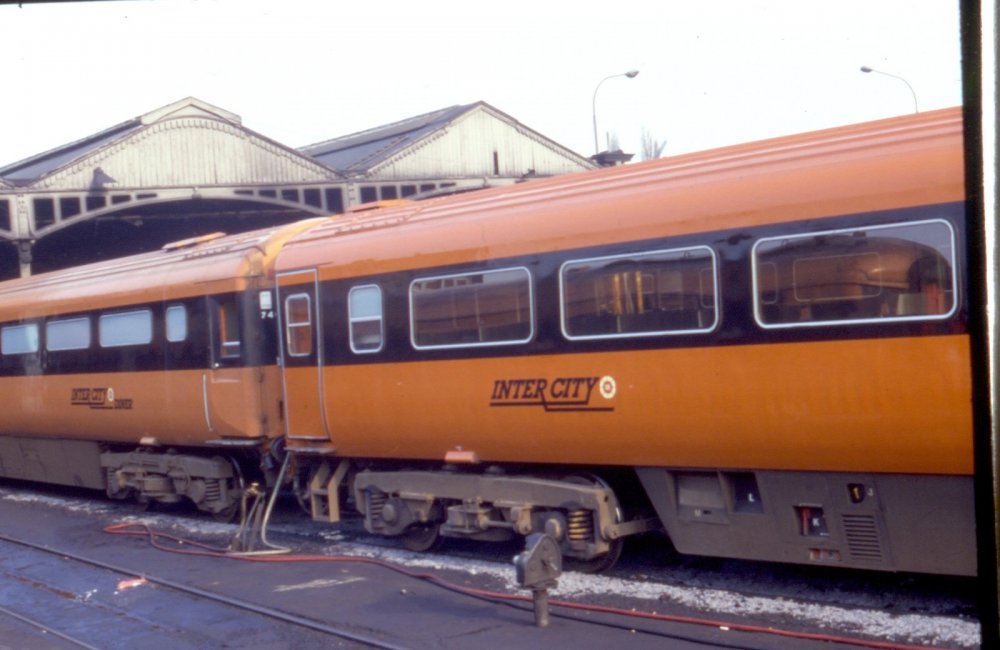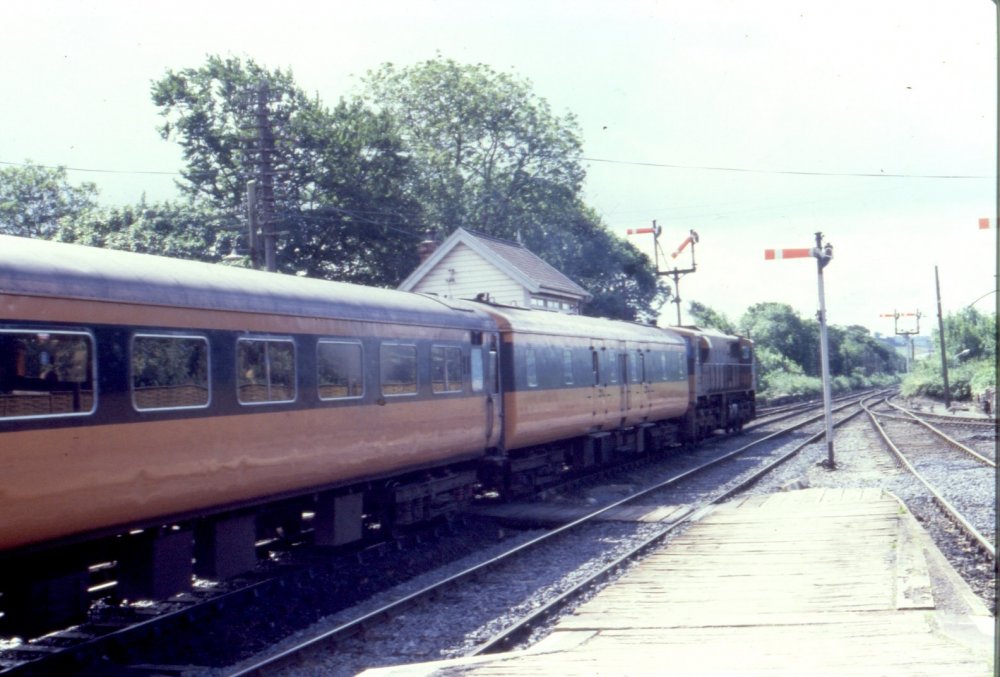-
Posts
4,861 -
Joined
-
Last visited
-
Days Won
119
Content Type
Profiles
Forums
Events
Gallery
Blogs
Store
Community Map
Everything posted by Mayner
-
With a light load and a near vertical jib there was no need to use outriggers and packing. The crane is actually being used as a "pick up and carry" crane to transport track panels between the train in the background and the worksite. Some of the smaller cranes like the Oxford model were sometimes 'self propelled" and could literally move at slow speed under their own steam, in this case a B141 is being used to travel the crane. BR tended to use small self propelled diesel cranes roof this type of work as they were less cumbersome than the large breakdown cranes.
-
A direct comparison of a SLA print and a plastic injection molded model a test print of a GSR grain wagon and a Ratio LNWR coal wagon. We went a bit heavy with the rivet detail on this wagon, but otherwise I am quite happy with the model and CAD work. The blemish on the side of the grain wagon is I tried to apply dry print lettering that is past its sale by date, we tried to push the boundaries on detailing with this model but ran into problems printing the hopper release gear which will have to be beefed up. The challenge at the production stage will be to avoid removing detail such as brake levers and linkages while removing the support structure at the factory. Although SLA printing appears to be a viable option for the small scale manufacture it remains to be seen whether its a viable option for the manufacture and assembly of rtr models. The next two months shall certainly test the concept for production of the brake van! The Chinese OEM factories that produce small production runs of <10,000 unit orders are only viable because they have the capability to take on and process orders from a number of clients simultaneously, a number of the companies that specialise in smaller production runs were set up by former employees when Kader decided to shut down a lot of its OEM manufacture to concentrate on its own in house brands about 10 years ago. This left Hornby and other competitors stranded until the present generation of Chinese OEM model railway manufacturers entered the market. I doubt that similar model railway manufacturing capability or experience exists in the West today
-
It looks like I haven't been out on walkabout/train chasing since last September mainly as a result of work & family commitments, but managed to take the afternoon off after a business appointment yesterday and check out operations on the Kinleith Branch in the South Waikato. The branch was built to serve a large paper and pulp mill in the South Waikato during the early 1950s, the mill was set up to process timber from plantation forests established in an area of the North Island Central Plateau that was then considered unsuitable for pastoral farming (dairy, beef and sheep) because of trace mineral deficiency in the volcanic pumice soil. The branch which then left the Hamilton-Rotorua line at Putaruru was basically an up-grade to a section of an existing logging line to main line standards to handle the output of the new paper mill, and timber and plywood mills along the route. Forestry and timber processing has become less significant during the past 20 years with mills closing and forestry land converted to pastoral farming with trace element deficiencies addressed through fertiliser use with dairy products from a new processing plant replacing finished timber and plywood as a traffic source on the Kinleith Branch. A cut of 10 container flats set out by the Te-Rapa (Hamilton)-Kinleith freight on the reception siding to the Fonterra Litchfield Dairy plant, main line in the foreground. Litchfield Plant Dry and Cold Stores in background siding to plant in middle distance. Tokoroa Road Rail Terminal built as a joint venture by KiwiRail, South Waikato District Council and RJL (a logistics business) the terminal was opened in 2016 to stimulate growth and employment opportunities in an area decimated by closures in the timber processing industry. The large timber processing (timber and plywood) processing plants served by the line closed during the last 20 years as NZ exports in finished timber and board products became less competitive. Kinleith the terminal of the line is basically a small marshalling yard beside SH1 a few miles south of Kinleith, with a yard office, small loco shed and CTC relay room. A laden log train awaits collection by an overnight Mt Maunganui (Tauranga Port)-Kinleith service, curtain-sider wagons for paper traffic are in the right background. I arrived in Kinleith just after the departure of the afternoon log & paper train for Mt Maunganui and the afternoon shunting service to Te Rapa. Yard office and wagons with export log traffic. The export log traffic took off after the GFC as the export of finished timber and ply became uneconomic as China and other export countries developed their own processing capability. Although the main line locos had departed there was still some activity as the yard shunter 3127 propelled a train of empty log wagons towards the Mill Yard. Crossing a local road 3127s driver controls the loco by remote control from the rear platform. The Mt Maunganui trains are basically "Caboose Workings" without a caboose, where the Road Locomotive does not carry out any shunting apart from uncoupling running round and coupling up at terminals. The local shunting crew are kept busy moving cut of wagons between Kinleith Yard and Mill and making up trains for departure. I had intended to check out a preserved Ollie Smith "Bush Tractor" a home made diesel loco at Mamaku on the Rotorua Branch on the may home but caught a glimpse of a Kiwirail loco propelling a rake of wagons into the Litchfield Dry Store so I had to check out. The white containers are for internal Fonterra traffic between processing plants in the Waikato Region and the companies Te Rapa store where consignments of dairy products are stored and consolidated for export and national distribution. The white containers are "High Cube" and restricted to the Waikato and Bay of Plenty as they foul the loading gauge on other routes. 9014 had propelled her train back to pick up a cut of flats with shipping containers with export products (most likely cheese) from the store! Train made up and ready to depart!, the travelling shunted has completed the brake test and completing his paperwork in the Ute before heading to Morrinsville to meet the train to carry out the next shunt. The 20' containers at the rear are carrying traffic from the Tokoroa Terminal. Train length 33 wagons approx 1100tonnes gross, Kinleith-Te-Rapa shunting service also serves a Cold Store and the Open Country Dairy plant sidings at Waharoa near Matamata (Hobbiton) but there is no work today. 9014 approaching Hutchison Road level crossing Kaimai Ranges in the background. I framed the train between two power pylons so the rear of the train is out of sight. I had hoped to get some shots of 9014 and her train on the attractive un-fenced roadside sections of line between Litchfield and Waharoa but could not get ahead of the train because of roadworks The train just about fits into the yard at Morrinsville clear of the trap points. 9014 & the "Hi Cubes" have uncoupled from the rear of the train and is about to propel back and couple to the flats with "Curtain Sider" containers on the left. The Curtain Side containers are from Fonterra plants in the Morrinsville area and have been left by the Te-Rapa-Morrinsville-Waitoa-Hautapu Shunting services which serves Morrinsville and two light axle branchlines in the area. Morrinsville had its own shunting loco and crew to serve Morrinsville and the Waitoa Branch until several years ago when the Morrinsville and Te Rapa-Hautapu shunting services were merged and main line locos used on the shunt with a lot of light engine movements between yards and plants. 9014 has coupled on to the curtain siders and cleared the middle road for the arrival of 9521 with a Te-Rapa Mt Maungauni freight 9521 appears to be mainly carrying Fonterra traffic in reefer containers, the shunter prepares to set the road for 9014s departure before driving to the opposite end of the yard to attach the cut of wagons with ISO containers to the east bound freight. 9014 departs Morrinsville with a solid block of Fonterra containers. It was getting late and did not stay around to watch the departure of the 9521 and her freight.
-
The main draw back with Shapeways seems to be that models like the MGWR 6 wheel coaches only appear to be available in White Natural Versatile Plastic which has a surface texture like rough cast plaster https://www.shapeways.com/product/QYWUZUKGH/0-76-mgwr-6w-brake-3rd-coach?optionId=96599245&li=marketplace Some models like the 47'6" flats are available in Frosted Ultra Detail (FUD) but the material is more expensive, has a layered effect and quite brittle, I managed to shatter some FUD parts. A superior surface finish without a layered effect should be achievable with Shapeways SLA materials, but a lot depends on the skill and experience of technician who sets up the CAD file on the printer and how the print house ensures that the model is not damaged during the clean up process and removal of the temporary support structure. https://www.shapeways.com/materials/sla-accura-xtreme/. The goods brake is a good example of the standard of surface finish and and level of detail that can be achieved by SLA printing, the wavy roof and coupler sag has been resolved in the final design.
- 68 replies
-
- 11
-

-
JM Design is currently testing the concept of producing rtr rolling stock using 3D SLA printing with our first production batch of CIE Brake Vans due to arrive from the printers in approximately four weeks. We considered commissioning rtr plastic injection molded wagons from China but decided on SLA printing as it would have been uneconomic to produce the Brake Van as a plastic injection model. While the majority of Chinese factories have a minimum order quantity of between 1500-2000 models, I would have had to sell far more than the minimum quantity to break even let alone make a profit. The lead time from starting 3D design work on the project to manufacture has been similar to that involved in commissioning a plastic injection model, the design costs using a professional designer are similar the main difference is that the tooling cost is absorbed into the unit cost of the model rather that an upfront cost for traditional tooling. I had planned to use a locally based 3D printing business for the production printing, but have had to outsource production printing to a company in China as it could not be done economically locally. I have a good working relationship with a locally based 3D printing business that carries out prototyping at a reasonable rate but was reluctant to quote for the production phase. The 3D print is just the starting point, there is also the issue of painting and lettering the model, sourcing components such as wheels couplings and bolts from suppliers and manufacturers on three continents and the little matter of packaging the finished model. To summaries 1. Commissioning a plastic injection model from China for less than 1500 models is likely to be un-economic unless you can charge a considerable premium. 2. The lead time to produce a decent SLA printed model is likely to be similar to commissioning a plastic injection model. 3. It may be necessary to outsource production printing, painting, assembly and detailing in order to produce a model at a competitive price.
-
While a maximum 65 (33bogie) train length was allowed on some routes in loose coupled days maximum tonnage hauled are similar to current day loadings as loose coupled wagons were lighter and had a lower load capacity than more modern stock. (laden corrugated beet wagon 18T gross-Ballast hopper 29.5T). Although crossing loops tended to be shorter in loose coupled days lay-by sidings up to a mile in length were provided for crossing trains that were longer than crossing loops on single line sections that carried heavy goods traffic such as Dublin-Galway and the Mayo Line. I suppose the bigger questions is whether apart from Tara, Ballina Beverages & Coillte there there is another shipper in Ireland capable of loading a 36TEU train to run from a single factory or a transport depot in Cork, Limerick, Galway, Belfast or Sligo to Dublin or Waterford Ports. CIE struggled to load 15 bogie 30TEU trains even before raod haulage was de-regulated in Ireland during the early 1990s.
-
3D printed Magnesite & Fuel Oil tank bodies to fit the IRM ballast wagon chassis would be the simplest would be the simplest may of modelling the Tivoli-Ballinacourty Magnesite and Oil trains with the IRM 001 class for haulage, with pairs of MM 141/181s on the Dolomite ore trains (IRM ballast wagons). Its possible to achieve a similar standard of finish to injection molded plastic using SLA printing though unit cost is higher than Shapeways, or if you are lucky enough to have a friend that can produce the CAD work and has a 3D printer.
-
I moved from OO to N gauge during the late 1970s mainly because I did not have space for a layout and mistaken belief that I would be less tempted to attempt scratchbuilding/kitbashing locos and rolling stock in N gauge, which was soon proved completely un-true. I ended up building an end-to end shelf layout based on current CIE practice using re-painted and modified Lima, Graham-Farish, Minitrix and Peco stock which passed the 2' rule. I originally re-painted the Lima BR Class 31 as an A Class and the Lima German center cab diesel as the GN Mak, but eventually ended up re-building Atlas American SW 1500 switcher locos into 121 & 141 Class diesels which became the mainstay of operations. The 141 and 001 had scratchbuilt plasticard bodies, while I fitted scratchbuilt plasticard cabs to the 121s and extended the bonnets with plasticard. my "Craven" coaches were simply re-painted Minitrix MK1s, though my "BR Vans" were kitbashed from Lima Mk1 coaches which had a narrower profile than the Minitrix coaches. Wagons were originally re-paints but some were later fitted with .010" plasticard overlays to look like the plywood bodied H Vans. The N gauge was abandoned following a house move during the early 80s and have mainly focused on kit and scratchbuilding in 4mm, but still have a soft spot for N scale particularly American . N gauge really come into it own when you don't try and fit too much into a relatively small space, basically the same amount of track as a similar sized OO or HO gauge layout.
-
127 worked a Push-Pull set on a South Eastern Section on a "Sea Breeze" or Enniscorthy festival special in the early 2000s . The south bound special was held to cross the up afternoon passenger and an empty Ammonia working at Greystones so it would have been a slow journey by any standards.
-
Although I did not see any trains the section of line around the headland at Ballyvoyle and the level crossings in Dungarvan left a profound impression on me as a kid on a family road trip from Dublin to Cork a couple of years before the line closed. I was lucky enough to travel over the line as a passenger in two IRRS Specials including one just before the line closed and later explored sections of the line. The line was probably was busiest and carried its heaviest tonnage during the days of the Quigley Magnesite operations, apart from the Boat Trains both passenger and goods traffic was quite light on the Mallow-Waterford line
-
The Push-Pull driving cars were originally designed to be convertible to diesel electric railcars with A/C traction motors hence the LHB bogies. IE applied for Government funding in the mid 1980s to build 20 MK3 based diesel railcars for suburban and branchline duties in addition to the 126? coaches in the Main Line MK3 programme. The application to build the railcars was rejected, instead authorisation was provided to build 6 Push Pull driving cars and the last 20 coaches of the MK3 programme were set up as trailer cars for Push-Pull operation. I have an IE/BREL drawing of a MK3 push pull coach titled "Railcar Trailer.
-
One of the distinctive spotting features of the Irish Mk3 coaches is that when viewed from rail level the bogies project out further past the body than a standard gauge MK3 coach, which would accentuate the narrow gauge appearance of a OO gauge Irish MK3. The disproportionate effect appears to be accentuated by the MK3 body profile and is less noticeable on the BR Vans and MK2 based stock which have a more conventional body profile.
-
That sounds a likely explanation, although there is a lot of pressure for non-resident retailers to export DDP, Customs Services are set up to levy duty and VAT at the point of entry and do not appear to be set up to process DDP shipments unless they arrive through the 'big boys" like E-Bay GSS or Amazon. I received a number of high value items ($400+) duty and tax paid from the States using the E-Bay Global Shipping Services interestingly there was no customs declaration or tax invoice on the parcels and they did not appear to have been stopped by Customs.
-
Loose coupled goods trains used to load to a maximum of 55 wagon or 1100' based on a wagon length of 20' over buffers. Currently Liner trains made up of 18 42'9" would be slightly longer than a train made up of 62'9" flats or Pocket Wagons, while an 18 wagon train made up exclusively of 47' ^6' flats would be substantially longer. Add 3' per wagon and allow for coupler slack to work out train length. Currently IEs liner trains are allowed to load to 36TEU (20' container) 18 bogie or 36 4 wheelers which is short/unprofitable by international standards. https://www.independent.ie/irish-news/news/watch-irish-rail-trials-longest-ever-440-metre-trains-34840428.html#:~:text=The company has trialled,rail network%2C a spokesman said.
-
1995/96 using 62'9" flat wagons (3-12 wagon trains) redundant following the end of mail traffic in 2003/4 The traffic built up fairly quickly and 2-3 additional trains using 2 axle 22'6" flats were converted to carry log traffic. Alterations to the wagons to carry log traffic was minimal IE fabricating de-mountable log cradles and bulkheads that could be removed from the wagon.
-
Traffic to Clonmel ceased in the early 2000s when IE lost the Coillte contract, traffic to Waterford resumed about two years later under a revised contract when Coillte took responsibility for loading/unloading including ensuring the load was secure before departure. Originally both the Clonmel and Waterford (Bellview) plants were planned to be rail connected, but ran into a barrier with IE apparently unable to obtain to obtain funding to construct private siding for freight customers. IE had been in negotiation during the mid 1990s to transport zinc from mines being developed in the Lisduff area but the traffic was lost to road after IEs funding application to the Department of Transport was rejected. The loss of the ore traffic from the Lisduff area marked a turning point in the fortunes of Irish Railfreight as IE seemed to be more pro-active that CIE and had been making headway in developing new traffic flows with minimal investment in new infrastructure or rolling stock such as grain, mollasses, domestic coal and pulpwood, the prospects of deepsea container traffic appeared promising with the opening of the new Bell Lines Belview Terminal and the long awaited EU funded connection to Dublin Port.
-
JIT evolved in Japan where different stages of the manufacturing process was carried out in a series of often independently owned workshops than in a single factory under one roof, using small vans and possibly handcarts to move components from the workshop to a factory for final assembly, This evolved into the Toyota Manufacturing Process and was later adapted by manufacturers in the West. Rail only appears to become a viable option for JIT manufacture for moving "train loads" (80-100TEU) to and from manufacturing plants, ports and distribution points, Irish freight trains have low capacity and transport light payloads by international standards. Although a lot of the JIT smaller shipments are moved by road, rail often forms an important part of the JIT manufacturing chain e.g. the IWT Liner is used as part of the chain to transport Coca-Cola concentrates from Ballina to manufacturing plants in Europe, the Coillte Log trains used to transport pulpwood to the Waterford OSB mill. In the UK rail has been used for many years to move steel, engines and other components to car assembly plants as part of a JIT manufacturing chain. Following the opening of the Chunnel the motor manufacturers integrated their UK and European supply chains using rail to transport vehicles and components between UK and European plants. In New Zealand rail is used as part of the distribution chain of the dairy industry both transporting raw milk (train load) from collection points to processing plants and in the transportation of dairy products to the ports for export.
-
The loss of cement Cement traffic was lost mainly due to Irish Cement loosing its monopoly position and the opening of the N50 Liffey Toll Bridge rather than strikes. Irish Cement lost market share in the North West, Midlands and East from the late 1980s with the opening of the Quinn Cement Plant in Derrylin and the Lagan Cement Kinegad. Competition from Quinn Cement lead to IEs loss of bulk cement traffic to Sligo. CIE closed the Cabra Bank Cement depot following the opening of the first phase of the M50 in the late 90s as it was simpler to supply bulk cement to the concrete plants in the Dublin area direct by road from Platin than by rail and road via Cabra Bank. The remaining bulk cement flows to Athenry, Cork, Tullamore and Waterford continued for several years after the ILDA strike and seem to have been lost when IE tried to increase their freight rates. I think that CIE/IE managed to hold on to railfreight for a long time because of CIE monopoly position, the poor state of the roads and streamlining freight operation and new rolling stock during the 1970s, conditions which had ceased to exist by 2000, with de-regulation of road haulage, good roads, a shift from commodity to a knowledge based economy and a worn out obsolete wagon fleet. Interestingly IE placed an order with a European manufacturer for new freight rolling stock including (bogie) bulk cement wagons in the early 2000s, but was forced to cancel because the IE railfreight division was unable to prepare a convincing business case. The big question with climate change and a post Covid environment is whether the current Globalised economic model with an economy based on exporting and importing goods and services to an from the opposite side of the World is sustainable.
-

Legal implications of using IE/CIE/Dublin Bus Logos & Liveries on models
Mayner replied to ShaneC's question in Questions & Answers
The Union Pacific Railroad sued MTH (A high end American O Gauge manufacturer) in 2005 when the railroad attempted to enforce a licensing agreement for the commercial use of UP trademark material including "fallen flag" companies. At the time it looked like the railroad saw the model manufacturers as a potential source of royalty income, rather than free advertising. MTH negotiated a royalty free licensing agreement for all model manufacturers that applies in perpetuity for both UP and "fallen flag" companies. https://mrr.trains.com/news-reviews/new-products/2006/11/mth-negotiates-new-union-pacific-licensing-deal-for-all https://www.up.com/aboutup/corporate_info/licensing/index.htm -
The first Tara ore shipments were dispatched through Foynes possibly in Barytes Wagons as a result of a dispute at Dublin Port. The Dublin Port Tara Terminal was built on Gouldings Wharf and redundant Gouldings Fertiliser workers picketed the Tara Terminal to put pressure on Gouldings to provide better redundancy payments.
- 1 reply
-
- 2
-

-

-
It could be argued that the ILDA loco drivers walked into a trap set by senior management and the established unions and played into the hands of a Government that had grown frustrated with infighting between CIE management and the Unions. The future of the railways was in doubt before the publication of the Strategic Rail Review in 2001?, Mary O'Rourke as Minister of Transport instructed CIE to sell/develop surplus land in order to fund investment in passenger services and the Government was not prepared to subsidise loss making freight services as it claimed that it could not subsidise businesses to transport freight. Discontent built up among drivers about the poor standard of representation by the the established transport unions, the feeling seems to have been that SIPTU and the National Bus & Railworkers Union did not adequately represent the drivers interests and formed ILDA in response to concerns with safety concerns to a new rostering agreement. SIPTU and the NBRU was likely to strike if IE negotiated with ILDA, the situation was resolved when ILDA members transferred to a British transport union that were able to secure negotiating powers. I my experience the biggest problem with unions like most large organisations is that they become process bound and often fail to represent or support their members at times of crisis.
-
I had some CIE tan aerosol mixed a couple of years ago , but got an orange peel effect when I attempted to spray a coach tonight. I am not sure if its a problem with the spray can nozzle or the paint mix I had the paint mixed to a RAL code but mislaid the colour reference. Does anyone know whether a BS. or RAL code exists for the tan used from the 1960s to the 80s Thanks John
-
In my experience freight trains usually depart once the train is loaded/unloaded, a driver and a path is a available rather than waiting until the scheduled departure time in the WTT. I don't know if IE has reduced passenger passenger train frequency because of Covid travel restrictions. I would imagine Boliden will scrap the privately owned Tara Mines wagons once Tara mine closes, Canadian (Group Eleven) & Australian (Glencore) mining interests have stakes in Pallas Green https://arkleresources.com/our-projects/zinc/. Its anyone's guess whether the Irish ore fields will be developed or the mining is worth the hassle when the tax payer has to pick up the tab for the ecological damage and clean up when mining finishes.
.png.c363cdf5c3fb7955cd92a55eb6dbbae0.png)


